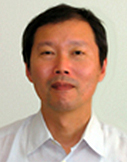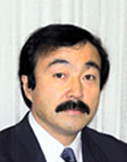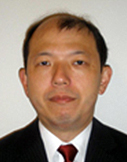The Second ISAS Award (FY 2015)
The JAXA ISAS is awarding the ISAS Award to those who come from outside our agency and have made remarkable achievements and contributions being the key to making the space science and exploration projects succeed.
The 3 persons below have been awarded the Second ISAS Award on January 6th, 2016.
Yoshinori Suematsu
Associate Professor of Scientific Project Hinode of National Astronomical Observatory of Japan(Solar physics)

Reason for Award
Development of the Solar Optical Telescope of SOLAR-B
Prof. Suematsu made great contributions to the solar observatory satellite SOLAR-B and the treatises on Hinode. He took part in the development of the 50cm Solar Optical Telescope which contains Japan’s original space telescope technologies and led the development of the key telescope optical system besides realizing high resolution performance.
The solar optical telescope installed on Hinode shew a stable performance with a spatial resolution of 0.2 arc seconds (150km on the sun’s surface). This is a Japan’s original space telescope technology which had never been realized in foreign space telescopes within the solar observation optical telescopes which receive strong sun lights.
Prof. Suematsu played the leading role consistently from optical design, all performance evaluations of the optical system and the on-ground optical performance demonstration, pursuing the high resolution performance.
Especially, he saw through the large aberration beyond the allowance in the on-ground experiments of on-board goods and in order to correct this, he designed the lens system and finished a telescope with a guaranteed diffraction limit performance.
Furthermore, he established the evaluation method for the optical performance of focal plane unit filter system and finally confirmed a high resolution performance with this method in the final experiment in Japan.
There have been over 900 peer-reviewed papers in these 9 years since Hinode was launched and the driving force is just the high-resolution pictures, videos and magnetic fields data from the SOT of Hinode. The excellent performance of SOT is not only known in Japan but also widely known abroad.
It was his devoted contributions that led to the success of the high resolution performance of SOT, which is just the success of Hinode.
Yoshinori Suematsu
Present position started since 2007, after being assistant at Faculty of Education, Shiga University, assistant and assistant professor at Solar Physics Division of National Astronomical Observatory.
Participated in the Hinode project from the beginning of the plan after the launch of Yohkoh.
Especially participated in developing and manufacture as the main person in charge of the optical design, optical system production and the optical performance evaluation tests, in order to reach the on-orbit diffraction limit of Solar Optical Telescope (SOT). After the launch of Hinode, he continued to participate in the operation of the satellite (became in charge of the Japanese side in the operation of SOT) and is taking an active part in the investigation of the solar observatory rockets and the next solar observatory satellite.
Makoto Ando
Member of the Management Committee and Executive Vice President for Research of Tokyo Institute of Technology
Professor of Graduate School of Science and Engineering of Tokyo Institute of Technology(RF Engineering)

Jiro Hirokawa
Professor of Graduate School of Science and Engineering of Tokyo Institute of Technology
Guest Professor of Department of Spacecraft Engineering, ISAS(RF Engineering)

Reason for Award
Development of the honeycomb-structured Radial Line Slot Antennas for ultra-long-distance communication installed on the asteroid explorer “Hayabusa 2” and the Venus Climate Orbiter “Akatsuki
Prof. Ando and Prof. Hirokawa led the development of the honeycomb-structured Radial Line Slot Antennas for ultra-long-distance communication installed on the asteroid explorer “Hayabusa 2” and the Venus Climate Orbiter “Akatsuki”.
The Radial Line Slot Antenna was invented in 1980 and has been constantly improved by Prof. Ando and Prof. Hirokawa. It has a high efficiency with very simple structures and compared to the parabolic antennas which have large storage volume and complicated structures, it has the advantage to make high gain antennas with flat panels only.
In order to reduce more weight which is necessary for installing on deep space probes, they used dielectric honeycomb cores as spacer and led the design and analysis considering the radio wave loss due to the material and the influences the honeycomb-structured hexagonal core parts have on the electromagnetic field.
Because of this, the conventional parabolic antenna on the Hayabusa probe was 1.6m in diameter, 0.9m high and weighed 6.8kg, while the planar antenna on Hayabusa 2 is 0.9m in diameter, 0.1cm thick and weighs 1.2kg. Although the gain reduced 22%, the weight significantly reduced 5.6kg, making great contributions to the completion of the Akatsuki and Hayabusa 2 missions, which required lightweight probes.
Makoto Ando
Received D.E. degree from Tokyo Institute of Technology in 1979.
Present position started since April 2015 after working at Yokosuka Electrical Communication Laboratory, NTT and being assistant, assistant professor and professor in Tokyo Institute of Technology.
Working on researches on the analysis of Electromagnetic wave diffraction and scattering. Started studying high-efficient planar antennas for microwaves and millimeter-waves installed on Akatsuki and Hayabusa 2 since 2005.
Jiro Hirokawa
Completed master's degree in Tokyo Institute of Technology in 1990.
Received doctoral degree by thesis only in Tokyo Institute of Technology in 1994.Present position since 2015 after being assistant and assistant professor in Tokyo Institute of Technology.
Working on researches on analyzing and designing waveguide planar antennas. Started studying high-efficient planar antennas for microwaves and millimeter-waves installed on satellites since 2012.
